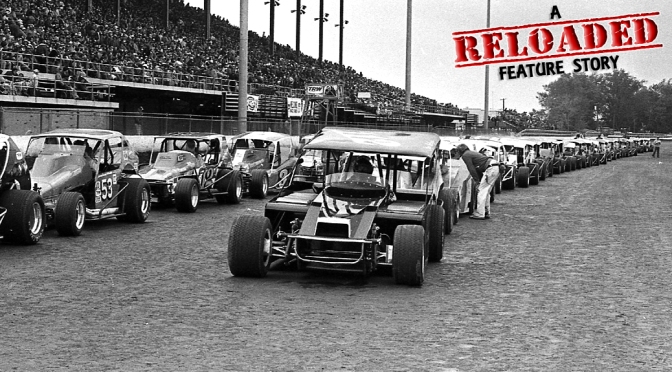Ad·vance·ment:
The progression to a higher state of development.
Advancement is indeed the fuel that has fed and strengthened our sport for so long. It’s considered one of the most important aspects of auto racing and thinking outside the box has driven that very advancement.
The masterminds of yesteryear’s racing machine builders and fabricators constructing their interpretation of the rules played the biggest roll in every four wheeled division we see today. Those forward thinking creative geniuses were equally as responsible for the all important advancement of safety.
In the 60’s, 70’s and 80’s the age of innovation on the Northeast oval track scene was in overdrive on both dirt and pavement. The battle of wits between competitors and rule makers resembled every bit of strategic warfare as they continued to push the envelope. The Northeast auto racing landscape not only changed mechanically, but physically and visually recognizable which peaked fan’s interest . The changes carried that all important buzz throughout each racing season regardless of whether you believed asphalt was for getting there, dirt was for planting potatoes or loved to play on or take in both types of racing .
Supermodifieds
Innovators o’plenty. Shampine alone had three creations..
The Formula One of short track asphalt ovals had so many advancements in that time frame by numerous builders. One was Jim Shampine who was as much an innovative creator as he was Supermodified’s greatest champion. Shampine alone unleashed three of Supermodified’s most talked about rides.
In 1969 Shampine showed up with a Supermodified everyone coined as “the Wedge”. It was the first Super to have it’s front axle outside of the body work with a nose that sloped down like a door jam, much like Andy Granatelli’s Indy cars. The engine set over to the left of the machine for more left side weight distribution. The nose piece changed through the years, but “the Wedge” continued to collect plenty of checkered flags. (Click here to view photos of “the Wedge” on Retro Rockets)
Shampine then unveiled “the Radical Offset” in 1976 which incorporated more weight distribution and seemed as though the engine was just hanging off the left side of this new Super. The tin work also made it easy on the eyes. Although Jim hardly campaigned it in ’76, by the time ’77 rolled around he was in “the Radical Offset” and winning as usual. (Click here to view photos of “the Wedge” & “Radical Offset” on Retro Rockets)
In 1979 Shampine got together with Kevin Reap who helped design and build a new creation nicknamed, “the Green Machine”. It was Shampine and Reap’s answer to the four wheel drive rear engine Supermodifieds that were beginning to challenge and beat the conventional cars. When Shampine finally figured it out he had picked up a feature win. In that year’s Oswego Classic, Shampine stuck to his trusty “Offset” and handed the Green Machine seat to rival Canadian driver, Warren Coniam. Shampine dropped out of the Classic. Coniam also ran into an issue early that placed him a lap behind the leaders, but Coniam made it up and was contending with the front runners until an oil leak ended his day late in the event.
After the 1979 season, in order to prevent anymore rise in costs to compete and build four wheel drive rear engined Supers, Oswego Speedway outlawed them from competition. Shampine’s Green Machine was obsolete at his home track after just one season. Shampine responded by quitting and went Sprint Car racing. (Click here to view photos of “the Green Machine” rear engined Supermodified on Retro Rockets)
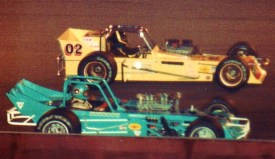
In late 1980 Shampine returned to Oswego in the 5 year old “Offset”. And when the Oswego Classic arrived, so did Jim Shampine with a strong determination to win. Shampine did just that by leading all 200 laps (still a Classic record) and scoring what most believe to be his most satisfying victory. That Radical Offset became the defined template of what Supermodifieds are today.
Pavement Modifieds
Because that’s what MODIFIED stood for!

The 60’s through 80’s asphalt Modifieds experienced so many changes in the technical side as well as physical appearance. The division produced every bit of the visual “eye candy” fans craved.
Ed Flemke and Raceworks turned out Modifieds that seemed to sit an inch lower with bodies that appeared to have that lean forward, low slung roof line with every new season.
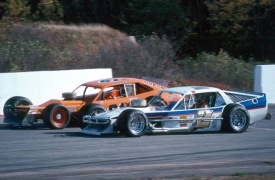
Geoff Bodine, Bob Cuneo, and Bobby Vee at Chassis Dynamics, not only dished out winners for Bodine, but notebly Bobby Vee’s two versions of the Busch beer sponsored number 2 in ’78 through ’80 and his infamous X6, equipped with dragster style breather in 1981 turned plenty of heads. The success of their creations turned plenty of their competitors into clients.
Richie Evans, Modified’s King, also ventured into new areas within the Modified realm. With the help of Kevin Reap, the same guy who helped design Shampine’s rear engined Green Machine a year earlier, Evans rolled out the “Straight Axle”. It was a different looking Modified and it worked. Evans never competed in it though. He chose a young kid, by the name of Michael Stefanik, to pilot the straight axle Modified at Thompson Speedway’s World Series. Stefanik answered the opportunity by contending for the win before dropping out. That off season the car was sold.
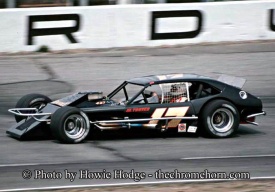
Maynard Troyer seemed to show up every season in the late 70’s with a lower roof line, stretched out body and more offset. His own machines were also nothing short of gorgeous. The success of his chassis created Troyer Engineering and made his cars the most sought after customer chassis in the division for years. Troyer also built Dean Hoag a Supermodified and would later start the “Mud Bus” Revolution in dirt Modifieds.
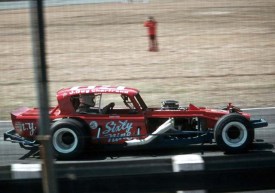
There were other builders and independents that created innovative Modifieds. The Pinto revolution was started by Bob Judkins. Charlie Jarzombek and family always had different looks that worked and won. Ed Close’s versions of his very own Hemi-Cuda were competitive entries for drivers like Jean Guy Chartrand, Jim Shampine and Chuck Ciprich. Fred Felton’s “Radical Racer” piloted by Kirby Monteith, Marty Radewick, Dwight Jarvis and John Rosati, drove tech inspectors nuts. Along with a list of others, they helped change the face of the asphalt Modified division by wreaking havoc with it’s rule makers and giving us fans sweet, sweet eye candy.
Dirt Modifieds
Again, because that’s what MODIFIED stood for!
In the 60’s and 70’s dirt Modifieds experienced plenty of changes chassis wise, mechanical and body styles. The bodies changed as manufacturers released new models. Coupe and coach bodies turned to Gremlins, Pintos, Vegas, Astres, Pacers (yes Pacers) even Plymouth Horizons and others littered the fields. Some of the Modifieds like Mike McLaughlin’s CraZ8 and Charlie Rudolph’s 72 were low slung like asphalt Modifieds. Although the dirt Mods had seen plenty of mechanical innovations and physical changes through the years, they lacked that extreme pushing of the envelope which led to the major changes their asphalt counterparts continued to have throughout those years. Change that caused the competition to rush back to their shops and start drawing out ideas and the rule makers to sweat, bite their fingernails and rewrite rule books.
Super Dirt Week IX
The Drivers.. The Prestige..
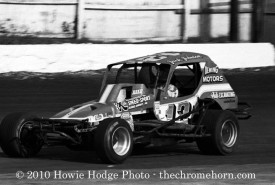
The dominating driver in 1980’s D.I.R.T. sanction was Jumpin’ Jack Johnson. Johnson capped off the 1979 season by tasting the Schaefer 200 champagne and carried that momentum right on into 1980. He was well on his way to the 1980 D.I.R.T. sanctioning body’s big block crown and many believed “Jumping Jack” was the favorite to repeat at Syracuse come October.
The challengers for the Schaefer 200 crown were the who’s who of the division; 1979 D.I.R.T. Champion, Will Cagle, Alan Johnson, Merv Treichler, Jimmy Horton, Kenny Brightbill, Buzzie Reutimann, Lou “the Monk” Lazzaro, Sammy Beavers, Billy Osmun, Dave Lape, C.D. Coville, Dave Leckonby, Frank Cozze, and the list goes on and on. Super Dirt Week also attracted high profile pavement Modified chauffeurs like Maynard Troyer, Jerry Cook, and Geoff Bodine.
Asphalt Modifieds had the CAM-2 Race of Champions, Oswego Classic and Thompson 300 which built up as the season progressed with guaranteed qualifying races at facilities all over the Northeast. D.I.R.T.’s Schaefer 200 had the same type of guaranteed starter events. The Schaefer 200 even went so far as to hold guaranteed starter races for pavement tracks too, like Scarborough, Maine’s Beach Ridge Speedway. Car counts of 140 plus for just the big block division made the New York State Fairgrounds the place to be when Super Dirt Week opened their gates.
So with the 1980 racing season drawing to a close and the premier season ending championship event about to begin, most of the dirt Modified community was totally unaware that Super Dirt Week IX would be the scene of a forced decade of change.
It began with the arrival of a dirt Modified who’s body work was designed and fabricated in Indianapolis, Indiana, chassis built and tested in Independence, Missouri and a driver who had tasted victory in that very event on three previous occasions.
And now for something completely different..
The BATMOBILE (“Orgazmatron”)
34 years ago, on a typically cool Wednesday in early October, a crowd surrounded a section of the pit area at Syracuse’s New York State Fairgrounds. And when the tarp was removed those in the crowd attempted to wrap their heads around what sat before them. The Modified Gary Balough would be piloting looked nothing like what any of us knew a dirt Modified to be.
Like many of us who attend races, Bob Scott was on the speedway grounds with family when Balough’s team found their parking spot, “I can remember the car coming into the pits with a tarp over it. Most everyone had heard that (Kenny) Weld was building a car for the race, but no one had any idea of what he was building. My father, brother and I thought it would be some tricked up version of his regular cars.. Until they pulled off the tarp.”
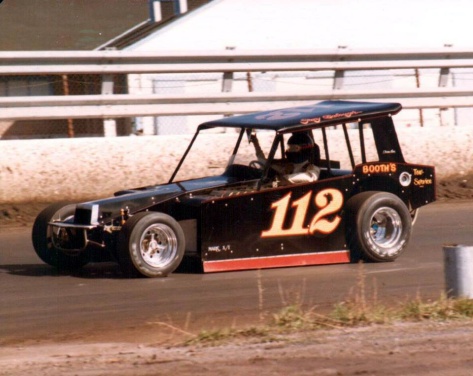
Balough explained that plans for the Batmobile started nine months before while he, Weld and others were in Florida, “We were at Speed Weeks when we decided we were going to build the car. Not long after that I had a bad wreck and broke my neck.”
Balough said thoughts of building the car were almost put on hold, “Kenny Weld came to visit me while I was in the hospital. Kenny figured any plans for the car were off because I had broken my neck. I told him ‘no way, we’re doing it’.”
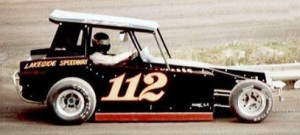
When I asked Gary if they had tested the Batmobile prior to their arrival at the New York State Fairgrounds, his answer was with a laugh, “Did we test it before Syracuse? Yeah we tested it. Sure. We tested it in Independence, Missouri on the same street Kenny’s shop was located. I drove it up the street, got it around and drove it back down. Kenny said that was good enough and I said ‘alright’ and got out.”
The first practice session arrived and that’s when all hell broke loose. Gary recalls, “When we went out in the first practice the track went green and right away we started passing a lot of cars. I thought, ‘Why is everyone else driving like we’re under caution?’ I really thought that. That’s how good the car was.”
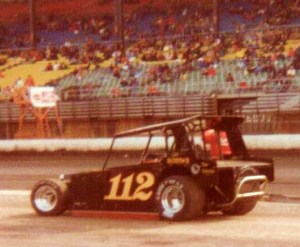
“We came in after practice, I got out of the car and Kenny asks how it felt. I told him the car ran great and felt amazing. He looked at me and said ‘I know, and now everyone else knows it too.”
Gary said Kenny figured he would run half laps, in other words, running it down the front chute and through turns one and two then back off and the next lap run the back chute and through three and four and back off. Gather enough info and combine the times to see where the car really is without showing the competition all your cards. That just wasn’t part of Gary’s make up when it came to driving, “I know what he was thinking, but I couldn’t do that you know? It’s just not me. When I get behind the wheel I don’t know anything else but seeing what she’s got. We never put it over three quarter throttle all week because I didn’t need to, but I really would have liked to.”
Balough easily grabbed the pole for the Schaefer 200 in Wednesday’s time trials. At three-quarter throttle and not many adjustments from the first rounds of practice, the 112 toured the track at 31.957 seconds, a speed of 112.853 mph. Sammy Beavers, racing for the same team Gary Balough had won his previous Schaefer 200’s with, the Ferraiuolo Brothers 73, timed second quick at 33.203 seconds, 108.433 mph.
The three second interval Kenny Weld told Lenny H. Sammons in Area Auto Racing News‘ 1990 10 year anniversary feature “The Batmobile”, must have increased in the final practice. Bob Scott clearly remembers, “The car was on rails right off the trailer. Late in the day, on Wednesday after time trials, they had practice for the Modifieds and Balough was turning laps almost as quick as the sprints.”
From Personal Memory
My first Super Dirt Week was indeed memorable..
My father and I arrived on Wednesday evening in the gold Speedway Scene Firebird and parked by the group of campers we were staying with. As soon as we walked around the corner where everyone was sitting and chatting, friends and acquaintances bombarded him with their eye witness accounts regarding the Batmobile. It continued on through the night.
Later, before we turned off the lights in the camper, my father was talking about all their accounts and commented the talk was probably similar to those “.. in the stands at Indy when Parnelli Jones put down his first laps in the Turbine.”
The next morning we hoped to see the 112 in all her glory, but no such luck. The 112 team was off-site at a shop nearby making slight adjustments and waiting for Sunday’s Schaefer 200. They only ran Wednesday’s pre time trial practice sessions, time trialed, ran the post time trial practice sessions and that was all until Sunday’s DIRT Modified main event.
Modifications
Some Decided to Change Their Game..
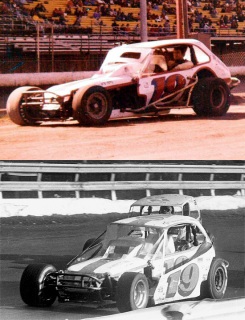
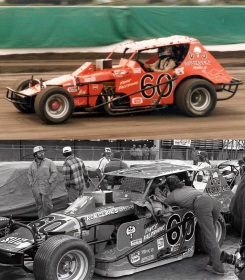
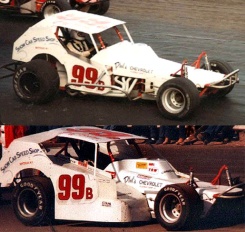
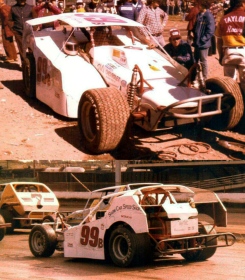
Before Sunday arrived a handful of teams had made alterations to their Modifieds in an attempt to match the machine Balough, Weld and team brought to the table.
Jimmy Horton and the number 3 Statewide team had rounded pods that ran as part of the body work which split and rolled over the top of the rear tires like fenders.
Kenny Brightbill and his 19 team gave the impression they had removed their spare car’s body, cut it in half and riveted it on both sides of their Modified while adding aero inside the new body panels. The original body was still intact, paint, numbers and all.
Merv Treichler and his 58 team took another approach. The body style on Treichler’s car was already a wide open type like that of a Plymouth Horizon or Dodge Omni so they decided to raise the roof dramatically far above the roll bars as if it was indeed a wing. Some folks later referred to it as the “red top hat”.
The Geoff Bodine-Billy Taylor 99B team, Buzzie Reutimann and the Vince Valeriano 60 team along with Frank Cozze’s number 44 entry did somewhat the same as Brightbill. They all widened their bodies with plenty of new or in some cases, used tin, added skirting, added the aero inside of new body panels, and opened up the rear of their Modifieds to allow free air flow.
As Maynard Troyer told AARN‘s Sammons in that same 1990 “The Batmobile” feature article, Geoff Bodine and Billy Taylor’s work paid off as when they brought their converted Modified back on Friday. Bodine went from 22nd fastest on Wednesday to second fastest Friday.
Schaefer Showtime
Dominating at Three-Quarter Throttle..
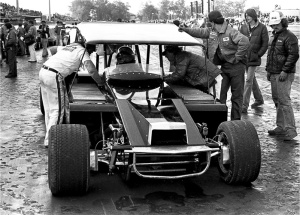
On Sunday when the Schaefer 200 took the green, just as expected, Gary Balough and the Batmobile ran away from the field and hid.
The most memorable moment for this writer was from race day. After pacing the field with the Gold Speedway Scene Firebird, along with twenty or so other pace vehicles, my father backed up to the fence just inside the infield guardrail off turn four. When Chief Starter Bob Watson finally dropped the green flag the field flew out of turn four in a giant roar. Coming around to complete lap number one, out of turn four, there went Gary Balough…..
Tic.. tic.. tic..
…..and there went the rest of the field. One lap and the 112 was already checking out.
Gary said they wanted to do things differently for the race, “We decided to start the race with the hardest tires we could find and planned on being the last to pit.”
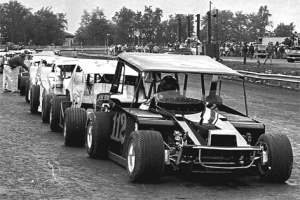
They pitted under caution on lap 73 placing them deep in the field for the restart. When the green flew again Balough easily cut through the field only passing on the straightaways and sometimes multiple cars per lap. It didn’t take much time at all before the 112 was back in the top spot and pulling away.
There was plenty of great racing action taking place throughout the huge field of Modifieds. However, by the end of the race, it seemed like almost every fan was focused on the resentment they felt towards the 112 Modified team and their driver. (Click here to view the 1980 Schaefer 200 results on The Third Turn site)
Boos, Jeers and Shaken Fists
As Balough, Weld, and crew celebrated the results of their hard work in victory lane loud boo’s filled the air with the covered grandstands assisting the sounds. ESPN’s Larry Nuber acknowledged the crowd’s discontent during his interview with the now four time Schaefer 200 winner, “Gary, there was an unpleasant response to the announcement of your victory, but I think it aught to be pointed out that you won this race three times in a conventional car. I don’t think it was all race car.”
While we discussed Super Dirt Week IX, I brought up that although many in attendance responded with booing there were other fans who appreciated the car. Gary quickly replied with a chuckle, “Really? Because I remember 50,000 people booing me in victory lane.”
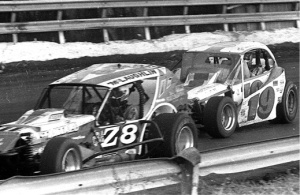
A great memory of achievement in his career, encased in a chorus of jeers. Multiple times during our conversation Gary spoke high praise of that team and how they all worked so hard on the car together. This particular win, with this car and the people who made it happen, was obviously something Gary took extreme pride in. It wasn’t about what he achieved from the cockpit that day, but what they accomplished as a team. I might add that most times when answering questions about the Batmobile he used “we” not “I”. Unfortunately, for him and the team, it’s hard for any of them to look back on the special moment without remembering the negative sound coming from the covered grandstands.
Mostly every driver who’s visited victory lane steadily has heard the chorus of boos. Jack Johnson, Alan Johnson, heck these days most folks love to hate Brett Hearn. After all, Balough was an established winner in dirt Modifieds and other forms of the sport. He had already proven he could win in big events, especially Super Dirt Week’s premier event. They showed up with a car that exploited rule book loopholes in an extreme manner, and dominated with an already proven winner behind the wheel. It was indeed the absolute perfect recipe for jeers.
It’s also the “nature of the beast” in sports and in many ways it’s one of the sport’s highest compliments, but it doesn’t mean those strong expressions of discontent didn’t sting. Like most successful and dominating racing creations, teams and drivers, that have come and gone in the sport, the appreciation for what they created, how the car and crew performed would only come sometime later.
Rumors and Myths
Most of their peers hated the Batmobile..
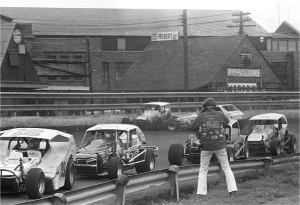
One thing that was brought up years ago was their fellow competitors didn’t appreciate what they built. Gary Balough said that couldn’t be farther from the truth.
As mentioned in Lenny H. Sammons’ 1990 AARN piece “The Batmobile”, Maynard Troyer and Merv Treichler gave a nod to the craftsmanship.
Gary says there were plenty of other guys that week who he ran into at the track or stopped by their hauler and complimented them on the creation, “Many guys thought the car was well crafted. Billy Taylor (Long time wrench for Geoff Bodine) was one of the guys who thought highly of the car. Of course drivers like Geoff and Buzzie didn’t like what we showed up with, but that’s because drivers like Geoff, Buzzie and others show up to win races. It didn’t mean they didn’t appreciate what we built because they did. I wouldn’t have liked it either if I were them, but it doesn’t mean I wouldn’t have appreciated it.”
The ground effects were just to hide the illegal motor!..
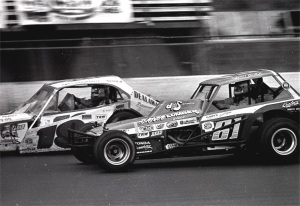
Some still speculate that the Don Brown and Tim Light ground effects package wasn’t a key factor to the Batmobile being dominant. They claim the ground effects and gadgetry were only a cover for an illegal power plant. Gary disagreed with the myths and rumors that even exist in published stories surrounding the Batmobile and that week, “That’s not true at all. The motor was built by Ron Hutter. It was just as legal as the Ron Hutter motors that powered Richie (Evans) and others to wins and championships. There was absolutely nothing illegal about that motor what so ever.”
Glenn Donnelly informed Sammons in “The Batmobile” article of 1990, they sent a D.I.R.T. Official to the shop in Indianapolis for a pre-inspection and on Super DIRT Week weekend the car was equally run through tech inspection at Syracuse. With all the hub-bub that the machine caused, and microscope it was under, if the engine was too big D.I.R.T. officials surely would have found out.
The car cost a fortune. They out-spent everybody!..
The team was accused of spending a fortune to build the machine, out pricing any Modified that was in the pit area. Again, referring back to the Area Auto Racing News article “The Batmobile” Sammons reported that Balough said in a pre-race interview, those beliefs were false. They had as much money invested in their machine as the top runners of the division had.
The differences between their Modified and the rest were the Don Brown and Tim Light ground effects package, perfectly legal tricked out custom Weld chassis (as if there was any other description for a Kenny Weld creation), and the much talked about air induction system.
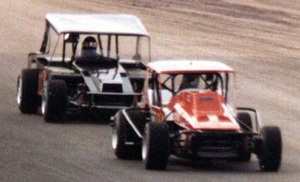
The air induction system has been one of the most discussed areas on the Batmobile. The most common description of the system was it forced air by way of the tin work channels under the hood that started at the chrome surrounded grill on the nose as well as through the duct work that ran back from the side pods of the car. The faster the car went, more air was pushed into the motor. The increase of air into the motor, the more power the motor produced. In 1981 and ’82, Schaefer 200 winner, Merv Treichler, along with other teams, had their own basic variations of the system with visible intakes on their Modifieds that fed air straight to the motor, but only direct through the front.
That car caused all the cars to look the same..
Some argue the Batmobile led to cookie cutter Modifieds. If making that claim with the immediate rise of the Troyer Mud Bus in mind, sure there were more and more customer cars coming out of Rochester, New York’s Troyer Engineering. Troyer came out with the Mud Bus and sold bunches, just as he had sold bunches on the asphalt side of things, because they worked.
In 1981 Alan “A.J. Slideways” Johnson and a couple others helped push Troyer’s Mud Bus orders up by tearing up the competition. However, others built chassis too and won just the same. Did that venture into producing dirt Modifieds stem from what took place that week? That’s a question only Maynard himself can answer. But placing blame on Weld, Balough and crew for making everything look the same is rubbish. One only has to go so far as to look at photos from 1981, ’82, ’83, and on to see clearly the differences started rolling on through the years much like the asphalt Mods experienced in the 70’s and 80’s. (Click here to view photos of 3 Wide’s Picture Vault from the 1980’s)
They caused the increase in costs to race..
Costs rose, but they rose throughout the sport in general. Again, if pointing to the mass production of the Mud Buss, it was no different than the mass production of Troyer’s asphalt Modifieds.
When a chassis is a proven winner and takes a division by storm it forces independents who normally would run the same chassis for a couple or so years to build a new chassis or purchase one from the mass producers like Troyer. It’s the old “If you can’t beat ’em, join ’em”. Sure that was a forced extra cost to compete, but it’s nothing that didn’t happen in other divisions. Remember sprint cars going through the Gambler Chassis phase? It seemed at one time half the field was running one.
Blame D.I.R.T.? Blame The Team?.. No, just blame the times.
What about Donnelly sending an official to Indianapolis for a pre-inspection? One interesting tid-bit that should be pointed out took place during ESPN’s live broadcast of the event. High ranking D.I.R.T. Official, Andy Fusco, answered on behalf of D.I.R.T. regarding the “surprise” arrival of the Batmobile, “That’s certainly an understatement. It started with one automobile here in practice on Wednesday that quite frankly we didn’t expect to be here and quite honestly we prefer not be here..”
Later some who saw the telecast and heard about Donnelly’s pre-inspection through certain channels started small grumblings, adding to the mystique of the Batmobile and how it was all handled. I recall my father conversing with his fellow friends in the press sometime later in the off season regarding the pre-inspection and contradicting statements during ESPN’s live telecast, but I personally can’t recall anything coming out in print until Lenny H. Sammons’ 1990 article.
In D.I.R.T.’s defense, what was any D.I.R.T. representative supposed to do or say? Were they expected to pick up the phone, call the racing publications and all its competitors to inform them about what Balough and Weld were bringing to Super Dirt Week IX? Should they have taken out ads in publications like Speedway Scene, Area Auto Racing News or Gater Racing News to inform the fans “Expect the worst and hope for the best”? No, of course not.
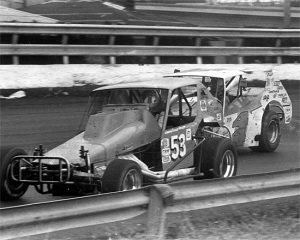
No one, but those involved with the 112 knew that it would run and run well. If they showed up and the new Modified was an absolute pig on the track it would’ve created that “point and laugh” effect.
D.I.R.T. did what was expected. The sanctioning body did what they had to do. They kept it close to the vest and hoped for the best. If Fusco were aware of the pre-inspection in Indianapolis prior to his statements, after Balough blew everyone’s doors off in practice and time trials, he stuck to his guns and guarded his sanctioning body. Anyone would have done the same thing. Their hands were tied.. Again, the car was completely legal.
Other than knowing for five days they would be competing and watching a race for second, the negative reaction towards the 112 team can be attributed to many factors.
The aforementioned length of time between someone pushing the envelope within the division, while other divisions continued to change shape dramatically through the seasons. On “Part 3” of the Super Dirt Week video broadcast that can be also found on YouTube, the late Larry Nuber goes over the differences in the conventional dirt Modifieds by comparing Brett Hearn’s entry and the revamped, re-tinned Geoff Bodine dirt Modified. Nuber mentions that the conventional Modifieds have been similar for the last 15 years. (All links to the ESPN telecast are listed at the end of this column for your viewing pleasure)
The Batmobile’s arrival within the absolute latest stage of the season in the biggest event also helped amplify the negativity. In auto racing ninety-five percent of all debuts occur at the beginning of the season. It’s the time when teams unveil the racing machines they labored on over the off-season winter months. The typical season kick-off events were where fans packed the house to not only cheer their favorite driver, but catch that all important visual review of the new machines being campaigned. When the big season ending championship events roll around, all involved in the sport; fans, competitors, officials and press, have seen the season unfold and believe we know what to expect.
Like all season ending championship events, we show up to see the best of the best competing against each other on an even playing field. Then something like the Batmobile comes along and decimates the field and sets everyone on their ear.
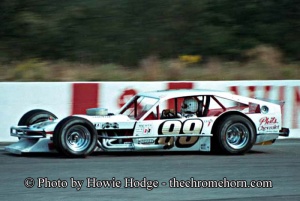
Just as Shampine did with “The Wedge” and “Radical Offset”, and Geoff Bodine and Billy Taylor did when they debuted the first Cavalier bodied Modified at Oswego’s Bud 200 and won, so goes Weld, Balough and the 112 team. They took the glory and off into the sunset they went leaving most everyone up in arms because it was nothing any of us expected.
Back to that heavily bushwhacked D.I.R.T. rule book.. When any rule book is looked at by brilliant thinkers, in this case Kenny Weld and Gary Balough, they will indeed find the loop holes. It’s only natural not only in our sport, but mostly all of sports. In the case of the D.I.R.T. rule book at the time, which was similar to every track’s rule book that ran dirt Modifieds, it held loop holes the size of elephants just waiting to be driven through. Common sense suggests, why pick and choose parts of the loop holes for a slight edge when you can go all in?
The Schaefer 200 winners share was a big pay day. Why do a little and take some when you can do it up and take it all? Really, what would you do? If you’re racing for big money it’s the latter. Forget what part of the season it is. Forget how long it has been since a significant change has come in dynamics. Forget taking it easy on the rule book. And above all throw any traditional beliefs right out the window. This is a thinking man’s sport. No one advances or wins by sitting idle and believing what’s worked will always work. In that day and age, you built it, worked on it and raced it to win and make money, and for some make a living.
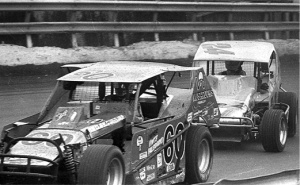
What would the reaction have been per say if Troyer showed up with his #6 Pinto bodied Modified in 1972 rather than 1977? How about Shampine’s “Offset” being debuted at the beginning of the ’70’s or his rear engined machine debuting in ’75? The same reaction that was shown towards Weld and Balough would very well have taken place because of the extreme physical and visible change in appearance and how advanced the machines would have been.
Don’t forget, just as soon as Shampine, for example, started winning races with his new creations the discontent among fans came in high numbers because of the unjust feelings of an unfair advantage crossed with the fact he’d dominated before.
As mentioned earlier, if any of the machines spoken about were absolute pigs on the track or merely even with the rest of the field, not a soul would have made a fuss. The creations would’ve been an afterthought within the racing community.
34 Years Later
Traditionalists fuss and argue that it changed dirt Modifieds as we knew it and ruined the division. I agree yet disagree wholeheartedly. It did, without a shadow of a doubt change the division forever, but by no means did it ruin the division. It created a spark within the division with chassis builders, designers and mechanics. Many Modifieds that were built in ’81 and beyond showed visual signs of forward thinking.
Dirt Modifieds today feature many characteristics to what Weld, Balough and team unveiled at Syracuse back in October of 1980. The ground effects inside the body panels, though not as complex, are somewhat similar in nature. The length of the door panels and the width of the body are similar. The skirting and the openings in the rear of the machines help “steer” the air. It’s been decades for the division to actually have any characteristics the Batmobile had.
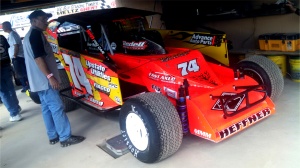
By all accounts the racing is just as exciting as back when four wheels first touched dirt ovals. The only thing that has changed are the tightening of the rules. Something that has been a heated topic for the past few years.
I spoke to Gary about how times have changed and I couldn’t agree with him more on his opinions regarding Modifieds, dirt or asphalt, “It’s sad today. There are so many rules in place now that no one has room to come up with something new. Way too many rules. Dirt Modifieds, asphalt Modifieds, they are called Modifieds for a reason and that’s been forgotten.”
Well said.
The Batmobile’s Return, Well Kind of..
With all that hard work put into the Batmobile’s ground effects, the Modified, as it ran that October, was outlawed almost immediately following their 1980 Schaefer 200 triumph and “broke up the band” per say. The Modified was sold to, coincidentally enough, Balough’s old team, the Ferraiuolo Brothers.
The Ferraiuolo’s reskinned and reworked the machine over the years and entered it in Super Dirt Week on at least five other occasions in different forms with different drivers. Heading into Super Dirt Week every year from 1981 to it’s last known appearance in 1987, carried with it the hype of the Batmobile’s return. The Ferraiuolos showed up with chauffeurs like Anthony Ferraiuolo III, Will Cagle, Doug Wolfgang and Merv Treichler. The questions always were, “what version of body work the Batmobile chassis would have this time?” and “would the Ferraiuolo’s show up with the right combination to return the legendary Weld chassis to the front?”. Unfortunately the versions to follow were never very successful, but God bless them for giving it their all.
1980 versus 2014?
The question has been asked every so often as each Super Dirt Week has come and gone, “Could the Batmobile compete against today’s Modifieds in it’s original form?”
Not withstanding the differences in the track surface over 30 years, here’s some food for thought..
This year at Super Dirt Week Matt Sheppard won the pole position with a fast time of 29.410 seconds, a speed of 122.449 mph.
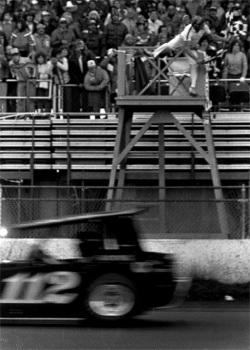
Balough and the Batmobile circled the Syracuse mile in 31.957 seconds, a speed of 112.853 mph, 9.5 mile per hour slower than Sheppard’s 2014 pole speed.
The second quickest in 1980 was Sammy Beavers time of 33.203 seconds, a speed of 108.433 mph which was 4 mph slower than Balough’s.
Many witness reports, including Bob Scott’s, said that Balough went out in a practice after time trials and was turning laps close to what the Sprint cars were setting for the Super Nationals that weekend. But let’s just say Balough’s times were indeed 3 seconds faster than the next Modified. If so, that would place lap times in or around 30.2 seconds and a speed of 119.205 miles per hour, raising his speed just under 3 miles per hour off Matt Sheppard’s 2014 pole time.
If Balough did a lap of 30.2 seconds it would have placed the 34 year old Batmobile 21st fastest in the 2014 Syracuse 200 time trials right behind Jimmy Horton and ahead of Carey Terrance.
If you consider the much talked about maximum “three quarter throttle” Balough and Weld said was only used the entire weekend and how they only made minor adjustments to the car all week, along with the fact that other than race day they only ran on Wednesday, a very strong argument could be made. And that argument being in it’s original form, the Orgazmatron / Batmobile / Lincoln Continental could very well be competitive at the Moody Mile 34 years later.
And the legend of the Batmobile continues..
T-E-A-M.. TEAM!
Chassis Builder, Kenny Weld was also the Crew Chief. Gary Balough as the Chauffeur. Pete Hamilton, the 1970 Daytona 500 winner was Balough’s Spotter/Driving Coach. Ron Hutter was the Engine Builder. Mario Rossi served as Motor Tuner. Eddie Labretone was also a Motor Tuner and served as a Tire Changer for the team along with Mark Clark and Bob Henry. Billy Sanchilli served as jackman on the car which was also equipped with air jacks. Tim Light and Don Brown engineered Aerodynamics and Sheet Metal for the Batmobile. Forgive me as I might have forgotten some others, but rest assured this group all had specialties. For a group of all stars to stick together from the Batmobile’s inception to it’s moment of glory at Syracuse speaks volumes about their belief in each other as a team.
Since 1981 the subject of conversation arises every year as each Super Dirt Week approaches and then passes. It always surrounds the team that stunned the community with their dirt Modified in 1980. The Batmobile will forever be one of the most discussed and argued over racing machines in American motorsports. They built and competed a perfectly legal and superior machine by interpreting the rules, finding the loop holes and helping dirt Modifieds evolve TEN YEARS.. IN FIVE DAYS.
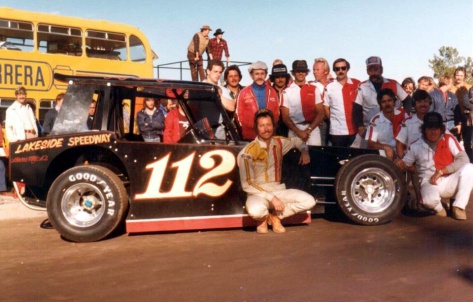
* * * * *
More Rumors and Myths Still Circulating..
Since the publishing of this feature in 2014 there are still those who question the Modified, the team, Kenny Weld, Gary Balough and DIRT’s officiating. So let’s review and clear all this up.
“The roof had shocks on it which allowed it to move like that of a SuperModified wing.” – That is a MYTH. The roof was mounted and not a movable piece. The roof was wide and did act as a wing, as any large wide roof would, but it did not move like a wing.
“Something broke on the Batmobile early in the race..” – That is TRUE. As incredible as it may sound, Gary Balough said the Batmobile actually had two issues occur. During my interview with Gary, he stated that the rocker arm broke on lap seven and not long after the engine had dropped a cylinder. Dropping a cylinder might really be a stretch for some to swallow, but not when you look at the facts. The aerodynamics and ground effects of the Modified included a large roof, side pods with skirting to direct air for rear steering, much like today’s dirt Modifieds. The air for the natural air induction system, that forced air directly into the engine, was not just fed by duct work beginning at the opening of the grill. The side pods also had channels which drove more air back into the engine. This air induction system increased the horsepower dramatically.
Again, “The engine was illegal.” – That is a MYTH and one that most surfaces by those still in disbelief that aero, ground effects and an air induction system could have given them that much of an edge. As stated earlier in the story, the engine came from the same builder, Ron Hutter, who’s power plants powered Richie Evans’ machines to National and track titles through the years. DIRT officials inspected the motor as well as inspected the futuristic Modified itself not once, but twice. The motor was perfectly legal.
Thank you to Gary Balough for his valuable time, insight and very enjoyable conversation.
Thank you to the Photographers for the privilege in granting me permission to use some really spectacular photos that preserve memories and allowed me publish the story with fine photographic descriptions that no words could truly describe..
Rick Sweeten (Feature Photo included)
Peter Montano
Howie Hodge
John Gallant Sr‘s by way of John Gallant Jr.
Bob Scott
Chad Frey
Special Thanks to a key individual, Joe at “3 Wide’s Picture Vault”. His site’s link to photos of the 80’s dirt Modifieds is provided in this column and a link to the site is listed with many other great racing sites on our links page. Thank you for your assistance Joe!
Sources referred to and quoted.. If you never had the chance to read the following time capsule of a piece, I recommend searching for it or going through your old stacks of Area Auto Racing News.
Sammons, Lenny H. “The Batmoble” Area Auto Racing News 2 Oct. 1990: 39,41,42. Print.
Other works of interest to which I acquired certain information for this story and equally enjoyed reading.
Bourcier, Bones. Richie!: The Fast Life and times of NASCAR’s Greatest Modified Driver : The Richie Evans Story. Newburyport, MA: Coastal 181, 2005. Print.
Fusco, Andy, and George Caruso. The Pine: The Authorized Biography of Jim Shampine, the Greatest Open Wheel Short Tracker of All Time. Oswego, NY: Speedway, 2003. Print.
ESPN’s Full Super DIRT Week IX Broadcast on Youtube:
Super DIRT Week IX – SCHAEFER 200 Part 1 of 17
Super DIRT Week IX – SCHAEFER 200 Part 2 of 17
Super DIRT Week IX – SCHAEFER 200 Part 3 of 17
Super DIRT Week IX – SCHAEFER 200 Part 4 of 17
Super DIRT Week IX – SCHAEFER 200 Part 5 of 17
Super DIRT Week IX – SCHAEFER 200 Part 6 of 17
Super DIRT Week IX – SCHAEFER 200 Part 7 of 17
Super DIRT Week IX – SCHAEFER 200 Part 8 of 17
Super DIRT Week IX – SCHAEFER 200 Part 9 of 17
Super DIRT Week IX – SCHAEFER 200 Part 10 of 17
Super DIRT Week IX – SCHAEFER 200 Part 11 of 17
Super DIRT Week IX – SCHAEFER 200 Part 12 of 17
Super DIRT Week IX – SCHAEFER 200 Part 13 of 17
Super DIRT Week IX – SCHAEFER 200 Part 14 of 17
Super DIRT Week IX – SCHAEFER 200 Part 15 of 17
Super DIRT Week IX – SCHAEFER 200 Part 16 of 17
Super DIRT Week IX – SCHAEFER 200 Part 17 of 17

